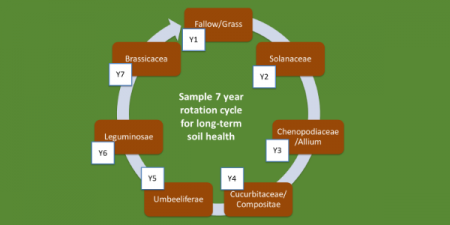Crop rotation? What’s that?
You’re probably familiar with the term “crop rotation.” Even if you aren’t, you can likely intuit what it is. In practice, rotating crops means that the plant families growing in every acre of our fields change from one year to the next. So although you can always find kale growing at Oxbow, you won’t find it in the same place, year after year.
Crop rotation is an important foundation of eco-agriculture and is rooted in a couple of key ideas:
1. It is a healthy way to manage pest pressure
First, pests and disease are more likely to set up shop in a certain field if the food there is always the same. If flea beetles, for example, munch all summer on a certain stand of collard greens, they are likely to lay their eggs nearby. When those eggs hatch in the following spring, it’s best for us if it’s not at the doorstep of another brassica.
Managing pest problems this way helps us avoid pesticide applications and keeps your food and farm healthy.
2. It maintains healthy soil
Crop families have somewhat specific nutritional needs, so we don’t want to grow two crops, back to back, that will draw heavily from the same bank of nutrients. If we follow a winter squash planting with a cucumber planting, for example, the cucumbers might have disappointing yields because the soil is especially low in potassium.
Crop rotation is a complicated juggle and we are developing a nifty system for handling it (see above for our ideal seven-year rotation). This method is successful for us only because we grow such a diverse variety of crops for our CSA.
By being a part of Oxbow, YOU make it possible for us care for the land while growing your food!
We’re capturing interesting moments this season and sharing them here to help you learn where your food comes from. Follow Story of a Season on our blog or on Instagram with #storyofaseason.
This story was originally published as part of our CSA newsletter, the Eater’s Digest. Interested in joining our CSA? Learn more about becoming a member.

